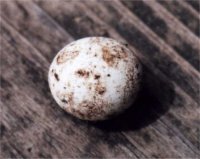Gecko
by Valerie (October 6, 2000)

One of the reptiles that moved into our yard fairly early in the evolution of our gardens was the gecko. The species living in and around our house is the introduced Mediterranean gecko, or warty gecko, although there are native Texas species in this area. Our geckos grow to about four inches and range in color from light tan with brown spots to charcoal color. The one pictured here is on the light side. These geckos are nocturnal and therefore extremely difficult to photograph, but this one happened to run up the side of the house in the early morning while I was watering. It would seem to be an easy solution to just capture one and then photograph it, but if they are handled, they cast off their tail. This is done to distract predators, and it certainly is distracting to see the separated tail wiggling away by itself. Geckos sometimes find their way into the house where they would probably die of dehydration, so we always catch them and put them back outside, usually with the loss of their tail. We also occasionally find the baby geckos caught in spider webs and this trauma produces the same result. The pictured gecko has a second-growth tail, which doesn't contain vertebrae, lacks the stripes, and has a different texture than the original.
The only time we can safely handle a gecko is when it is still in its eggshell. Typical egg-laying locations in our yard include the dog's house, the garage, between rocks in the gardens, and under leaf litter. For a small lizard, the eggs are relatively large, being about ½ inch long. The female produces only a couple at a time, and they are sometimes visible beneath her translucent skin.
|
 Besides being excellent insect control, geckos are fascinating creatures. They are one of the few lizards that don't have eyelids, showing their close relationship to snakes. They are also very fast and capable of climbing up walls and on ceilings by using special pads with ridges on the bottoms of their feet, which are covered by minute bristles. Recent research has shown that the huge surface area of all those bristles allows the gecko to "stick" to surfaces with quite a bit of force. They actually have to peel their toes off with each step to break the adhesive bond. Geckos avoid wet surfaces because they can't walk on them as well. They are extremely wary and always run and hide during the daylight hours. At night they can be observed as they hunt around the outside lights by our doors.
Besides being excellent insect control, geckos are fascinating creatures. They are one of the few lizards that don't have eyelids, showing their close relationship to snakes. They are also very fast and capable of climbing up walls and on ceilings by using special pads with ridges on the bottoms of their feet, which are covered by minute bristles. Recent research has shown that the huge surface area of all those bristles allows the gecko to "stick" to surfaces with quite a bit of force. They actually have to peel their toes off with each step to break the adhesive bond. Geckos avoid wet surfaces because they can't walk on them as well. They are extremely wary and always run and hide during the daylight hours. At night they can be observed as they hunt around the outside lights by our doors.